This section of the directory addresses
legislation and policy on cultural and natural heritage in the coastal
zone. There is a large degree of cross over between legislation (which
includes International legislation, European legislation and National
legislation) and policy which is either National policy or Local Area
policy. As such this section is not easily divisible. However, it has
been attempted to present the resources available in the following format
for ease of research and interrogation:
NATIONAL HERITAGE PLAN
PLANNING LEGISLATION
CULTURAL HERITAGE LEGISLATION
NATURAL HERITAGE LEGISLATION
BIODIVERSITY POLICY
ENVIRONMENTAL IMPACT ASSESSMENT LEGISLATION
MISCELLANEOUS ACTS
LOCAL AUTHORITY PLANS & POLICIES
 |
| Cannons at Duncannon
Fort, County Wexford |
The National Heritage Plan (2002) sets out a comprehensive strategy
and framework for the protection and management of heritage for the
period 2002-2007. It considers natural, archaeological and architectural,
as well as moveable, documentary and archival heritage.
The overall Government policy statement, as laid out in the plan, is
to ‘ensure the protection of our heritage and to promote its enjoyment
by all’. The plan states that in seeking to meet this objective,
the Government will:
-
place the protection and enjoyment of heritage at the heart of public life;
-
promote the measures required for the protection of our heritage;
-
encourage the accumulation of the knowledge necessary to protect our heritage;
-
promote awareness and enjoyment of our heritage; and
-
play an active role in heritage protection in a cross-border and international context.
The plan lays out priority actions, including development of Local
Heritage Plans and implementation of the National
Biodiversity Plan. Copies of the National Heritage Plan can be obtained
from the Heritage Policy Division of the
Department of Environment, Heritage and Local Government. Digital
copies will be available from the NPWS
website.
In relation to coastal and marine heritage, the plan lists as an action
to integrate heritage at a national level: Prepare and adopt, on a cross-Departmental
basis, a National Coastal Zone Management Strategy making specific provision
for the conservation of heritage.
Having identified gaps in knowledge on maritime heritage, the plan
specifies to initiate surveys of the archaeological heritage, as part
of the Archaeological Survey of Ireland. These surveys give priority
to environments which have a high potential for containing previously
unrecorded sites and which are under threat such as:
· Inter-tidal zones,
· Coastal areas subjected to erosion and
· Geophysical and dive surveys of known and potential underwater
archaeological sites in coastal waters.
PLANNING
LEGISLATION
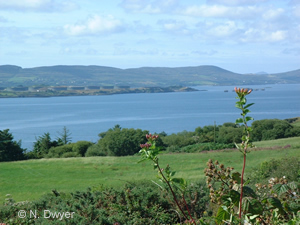 |
| Whiddy Oil terminal
in Bantry Bay |
-
conservation and protection of the environment, including, in particular, the archaeological and natural heritage and the conservation of European sites;
-
preservation of the character of the landscape;
-
protection of structures of architectural, archaeological, historical, cultural and other interest;
-
the preservation of the character of architectural conservation areas; and
-
the protection of the linguistic and cultural heritage of the Gaeltacht.
Additionally, development plans may contain objectives in respect of:
-
preserving and protecting flora, fauna and ecological diversity;
-
protecting features of the landscape which are of major importance for wild fauna and flora;
-
preserving and protecting trees, shrubs, plants and flowers preserving the quality and character of urban or rural areas;
-
protecting and preserving (either in situ or by record) places, caves, sites, features and other objects of archaeological, geological, historical, scientific or ecological interest;
-
regulating and controlling the design, colour and materials of structures and groups of structures, including streets and townscapes and structures and groups of structures in rural areas; and
-
preserving the character of the landscape, including views and prospects, and the amenities of places and features of natural beauty or interest.
There are several mechanisms available to a local authority under the act to enable it to conserve its area’s heritage. A local authority is required to make a Record of Protected Structures to protect its built heritage. In order to preserve a landscape a planning authority can also designate a Landscape Conservation Area. This designation can have the effect of de-exempting agricultural activities such as land reclamation and the removal of field boundaries, which are otherwise exempt from planning permission. The new act provides for the making of Special Amenity Area Orders in respect of areas of outstanding beauty or special recreational value. In deciding upon a planning application a planning authority must take into account the provisions of its development plan or of any Special Amenity Area Order and have regard to SPAs, SACs and any other areas prescribed ‘for the conservation and protection of the environment including in particular, the architectural and natural heritage and the conservation and protection of European sites…’. For the full text of the Act, click here. The Act was implemented by the Planning and Development Regulations, 2001.
Foreshore Acts 1933 - 1998
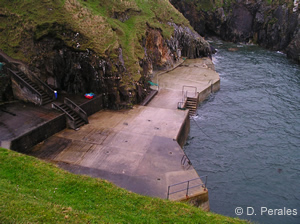 |
Pier at Malin Beg, County Donegal |
Planning matters in relation to the foreshore are regulated by the
Foreshore Acts 1933-1998. This legislation relates primarily to the
licensing of activities in the foreshore and does not contain specific
objectives aimed at heritage protection. The Foreshore Acts, 1933 to
1998, comprise three Acts, namely,
1. Foreshore Act, 1933 (Click here)
2. Foreshore (Amendment) Act, 1992 (Click here)
3. Fisheries and Foreshore (Amendment) Act, 1998 (Click here).
The Acts require that a lease or licence must be obtained from the Minister
for Communications, Marine and Natural Resources for undertaking any
works or placing structures or material on, or for the occupation of
or removal of material from, State-owned foreshore. The foreshore is
the seabed and shore below the line of high water of ordinary or medium
tides and extends outwards to the limit of twelve nautical miles. Leases
are granted under the Acts for the erection of long-term structures
(e.g. piers, marinas, bridges, roads, carparks) and licences are granted
for other works (e.g. laying of submarine pipelines and cables) and
activities (e.g. aquaculture).
The 1992 amendment gives the Minister power to ban sand or stone removal
from the foreshore, to ban any specified method of sand removal, to
control the quantities or times of any removal or disturbance, to ban
any activity or vehicle which disturbs the seashore, e.g. by laying
it open to wind or tidal erosion or by damaging indigenous plant or
animal life. Certain developments on State-owned foreshore are subject
to the European Communities (Environmental Impact Assessment) Regulations,
1989 to 1999, requiring the preparation of an Environmental Impact Statement
which must be provided to the consultative organisations specified in
the Foreshore
(Environmental Impact Assessment) Regulations, 1990.
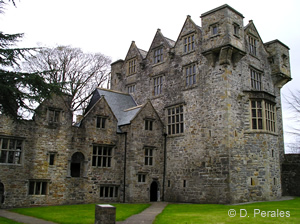 |
Donegal Castle |
INTERNATIONAL CHARTERS
ICOMOS (International Council on Monuments and Sites) Charters
The International Council on Monuments and Sites (ICOMOS) is a UNESCO sponsored organisation that has promoted and overseen development of the modern principles and practice of conservation through a series of Charters aimed at the protection of built and cultural heritage.
Venice Charter
The 1964 ICOMOS International Charter for the Conservation and Restoration of Monuments and Sites, otherwise known as the Venice Charter, was the first of these charters. It lays down the primary statements of principles on the conservation of historic buildings.
Washington Charter
The 1987 ICOMOS International Charter of Historic Towns and Urban Areas, otherwise known as the Washington Charter, includes a recommendation that planning for conservation of historic towns and urban areas be preceded by multidisciplinary studies in the form of a conservation plan. It also states that conservation of historic towns and urban areas should be an integral part of coherent polices of economic and social development and of urban and regional planning at every level.
The Burra Charter
The 1999 Australia ICOMOS Charter for the Conservation of Places of Cultural Significance, the Burra Charter, promotes a more holistic view of the significance of a monument or place. It states that conservation involves all the processes of looking after a place so as to retain its cultural significance.
Charter for the Protection and Management of Archaeological Heritage
The ICOMOS Charter for the Protection and Management of Archaeological Heritage was approved by the ICOMOS General Assembly in 1990. This is a large scoping charter designed to protect all archaeological heritage and provide national legislatures with an approved foundation from which they can develop national legislation. It also defines ‘archaeological heritage’ in an international sense.
Charter for the Protection and Management of Underwater Cultural Heritage
The Charter for the Protection and Management of Underwater Cultural Heritage was ratified in 1996. It provides an internationally accepted definition of ‘underwater archaeological heritage’ and aims to provide a code of practice for maritime archaeologists and institutions. This code is flexible and can be applied to any marine project. It has no national bias but is based on accepted archaeological principles.
To read more about ICOMOS and the various charters, click here.
European Maritime Heritage
 |
| Former Lightship
and now Maritime Museum in Kilmore Quay, County Wexford |
The European Association for Traditional Ships in Operation
European Maritime Heritage (EMH) is a non-governmental organization for private owners of traditional ships, as well as for maritime museums and other interested bodies. The objectives of the EMH exclude any pursuit of profit, and are:
- to encourage mutual cooperation between the extensive community of organizations in Europe, including museums, involved in keeping maritime heritage alive
- to act as a conduit for the flow of advice and assistance between such organizations
- to contribute to the mutual understanding of different maritime cultures and increase public awareness of those cultures, by organizing a triennial congress
- to identify and promote historic water-borne links between European regions, publicizing the role waterways as a cultural bridge between the nations
- to study and resolve common problems identified in the course of preserving and operating traditional craft in Europe
- to provide official organizations of the European Union with a representative and consultative service on all aspects of preserving and operating historic boats and vessels
For further information on the European Association for Traditional Ships
in Operation, click here.
Barcelona Charter
The 2002 European Charter for the Conservation and Restoration of Traditional
Ships in Operation (The Barcelona Charter) was adopted by the European
Maritime Heritage Congress with the aim of preserving and restoring
traditional ships in operation in order to safeguard them - whether as
works of art, as historical evidence or for perpetuating traditional skills.
The Charter defines the concept of maritime heritage afloat as embracing
the ‘single traditional ship in which is found the evidence of a
particular civilisation or significant development as well as traditional
sailing, seamanship and maritime workmanship’. It applies both to
larger ships and to more modest craft of the past, which have acquired
cultural significance with the passing of time. For further Information
on European Maritime Heritage and the Barcelona Charter, click here.
Council of Europe Conventions
Granada
Convention
The 1985 European Convention for the Protection of the Architectural Heritage
(Granada Convention) built on the policies and recommendations of the
ICOMOS Charters. It introduced the concept of integrated
conservation through which conservation should be considered not as a
marginal issue, but as a major objective of planning. The Convention has
directly influenced Irish legislation for the protection of cultural heritage.
For example the Architectural
Heritage (National Inventory) & Historic Properties (Miscellaneous
Provisions) Act, 1999, established a National
Inventory of Architectural Heritage and provides statutory protection
of that heritage. The Irish Government ratified the Granada Convention
in 1997. To read the full text of the Convention, click here.
The Valetta Convention
The 1992 European Convention on the Protection of Archaeological Heritage
(The Valetta Convention) provides the basic framework for policy on the
protection of archaeological heritage. It is a formal acknowledgement
that the archaeological resource is non-renewable. In summary, the obligations
on the state, archaeologists and developers under the Convention relate
to:
- providing statutory protection measures,
- authorising and supervising of archaeological activities,
- implementing measures for the physical protection of the archaeological heritage,
- providing consultation between archaeologists and planners,
- facilitating the study of archaeological discoveries by making or bringing up to date maps, surveys and inventories of archaeological sites.
Ireland ratified the Convention in 1997. In so doing it accepted the requirements to institute a legal system for the protection of the archaeological heritage; maintain an archaeological inventory, designate protected monuments and implement mandatory reporting of the finding of archaeological objects. A number of amendments to the National Monuments Act resulted from the adoption of this convention. These changes included the restriction of use of detection devices, the controlling of archaeological excavations and, where possible, the preference for preservation in-situ rather than excavation. To read the full text of the Convention, click here.
NATIONAL
LEGISLATION
National
Monuments Acts 1930-1994
 |
| Rockfleet Castle
in Newport Bay,County Mayo |
1. A Monument as defined by the act can relate to archaeological and architectural heritage, above or below ground or water. In relation to the built heritage it is defined as any artificial or partly artificial building, structure or erection or group of such buildings, structures or erections.
2. A National Monument is a monument the preservation of which is a matter of national importance by reason of its historical, architectural, traditional or archaeological interest.
3. An Historic Monument includes any prehistoric or later monument associated with the commercial, cultural, economic, industrial, military, religious or social history of a place and includes all monuments predating 1700 AD.
4. An Archaeological Area is an area considered to be of archaeological importance.
Under the acts Monuments, Historic Monuments, National Monuments and Archaeological Areas are protected by a number of means.
1. The Register of Historic Monuments: This register was established by the National Monuments (Amendment) Act 1987. Site or building owners have to be informed that their property is to be included on the register. The process is therefore more cumbersome and protracted and had in 1999 only 5,000 entries. Protection to monuments listed in the register is through the implementation of development control carried out by the Local Authority.
2. The Record of Monuments and Places (RMP): Under the National Monuments (Amendment) Act 1994, the pre-existing non-statutory Sites and Monuments Record was replaced by the Record of Monuments and Places. Under the new act, protection is now given to the sites and monuments in the RMP. Protection to monuments listed in the RMP is provided through the implementation of development control carried out by the Local Authority.
3. Preservation Orders: The Minister can make a preservation order providing that a monument …is a national monument, is in danger of being or is actually being destroyed, or is falling into decay through neglect. The Minister may also make a temporary preservation order where a monument is considered to be a national monument.
Under the 1987 amendment, all shipwrecks over 100 years old became protected sites and any investigation of these sites required prior approval from the Minister. Additionally, there was a restriction put on the use of detection devices. The amendment act also refers to the Merchant Shipping (Salvage And Wreck) Act, 1993 which considers it an offence to withhold information relating to the removal of material from wrecks and provides Gardaí with powers to search and seize material plundered from a wreck. The 1994 amendment saw a new definition as to the ownership of archaeological objects. Under this new definition all archaeological objects become the property of the state. Click to read the full text of the 1930, 1954, 1987 and 1994 Acts.
National Monuments Act 2004
The 2004 amendment Act was brought in to clarify the division of responsibilities between the Minister for Environment, Heritage and Local Government, the Minister for Arts, Sport and Tourism, and the Minister for Finance along with the Commissioners of Public Works. The Act gives discretion to the Minister for Environment, Heritage and Local Government to grant consents or give directions in relation to national monuments, which take into account the wider public interest, rather than solely archaeological considerations.
Architectural Heritage (National Inventory) & Historic Properties (Miscellaneous Provisions) Act, 1999
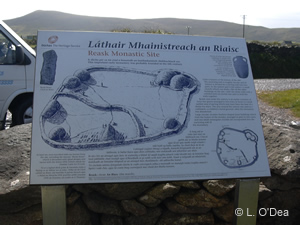 |
| Signage at Reask
Monastic Site, County Kerry |
This Act was a direct response by the Government to the Granada
Convention, ratified by Ireland in 1997. It provides protection for
architectural heritage, which it defines as:
i. structures and buildings together with their settings and attendant
grounds, fixtures and
ii. groups of such structures and buildings; and
iii. sites; which are of architectural, historical, archaeological, artistic,
cultural, scientific, social or technical interest. Architectural heritage
is also afforded protection under the Planning
& Development Act, 2000. The Architectural Heritage & Historic
Properties Act established the National
Inventory of Architectural Heritage (NIAH). To read the full text
of the Act, click here.
Heritage
Act 1995
The Heritage Act is to promote public interest in and knowledge, appreciation
and protection of the National Heritage and to establish a body to be
known as An Chomhairle Oidhreachta (The
Heritage Council). The functions of the Council are to propose policies
and priorities for the identification, protection, preservation and enhancement
of the national heritage. National Heritage is defined as including monuments,
archaeological objects, heritage objects such as art and industrial works,
documents and genealogical records, architectural heritage, flora, fauna,
wildlife habitats, landscapes, seascapes, wrecks, geology, heritage gardens,
parks and inland waterways. The Council has a particular responsibility
to promote interest, education, knowledge and pride in the national heritage.
To read the full text of the Act, click here.
Planning and Development Act 2000
Part IV of the Planning and
Development Act, 2000 relates specifically to the Architectural Heritage
and emerged in response to the 1985 European Convention for the Protection
of the Architectural Heritage (Granada
Convention). The convention emphasised the importance of an inventory
system, integrated conservation and the establishment of common principles
and obligations for signatories with regard to the identification of properties
for preservation and the implementation of statutory protection procedures.
Under the Act local authorities are obliged to have a Record of Protected
Structures. The Planning & Development Act, 2000, incorporates the
Architectural Heritage
(National Inventory) & Historic Properties (Miscellaneous Provisions)
Act, 1999, which provides for the protection of the architectural
heritage. To read the full text of the Act, click here.
The
Continental Shelf Act 1968
This act is referred to in the National Monument Amendments 1987, 1994
and makes provisions in relation to the exploration and exploitation of
the continental shelf. To read the full text of the Act, click here.
International Conventions
Convention on Biological Diversity (1992)
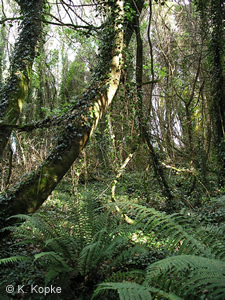 |
| Diverse Forest habitat
at Rostellan Woods, County Cork |
· The conservation of biodiversity;
· The sustainable use of its components; and
· The fair and equitable sharing of the benefits from the use of genetic resources
Biological Diversity, or Biodiversity, is defined in the CBD as
“the variability among living organisms from all sources, including, inter alia, terrestrial, marine, and other aquatic ecosystems and the ecological complexes of which they are part; this includes diversity within species, between species and of eco-systems”. Parties to the CBD have agreed a target to achieve by 2010 a significant reduction of the current rate of biodiversity loss at the global, regional and national level. Ireland ratified the Convention on Biological Diversity in 1996, and gave a commitment in 1998 to implement it. Although there is no national legislative framework for its implementation in Ireland, a National Biodiversity Plan was published in 2002. For more information on the Convention on Biological Diversity and the importance of biological diversity for the health of people and the planet, click here. For the full text of the Convention on Biological Diversity, click here.
Convention for the Protection of the Marine Environment of the North-East Atlantic (OSPAR)
The 1992 OSPAR Convention is the current instrument guiding international cooperation on the protection of the marine environment of the North-East Atlantic. It combined and up-dated the 1972 Oslo Convention on dumping waste at sea and the 1974 Paris Convention on land-based sources of marine pollution. The work under the convention is managed by the OSPAR Commission, made up of representatives of the Governments of the 15 Contracting Parties and the European Commission, representing the European Community, and is organised under six strategies:
· Protection and Conservation of Marine Biodiversity and Ecosystems
· Eutrophication
· Hazardous Substances
· Offshore Oil and Gas Industry
· Radioactive Substances
· Monitoring and Assessment
Of direct concern to natural heritage and nature conservation is the Biological Diversity and Ecosystems Strategy, which is concerned with all human activities (excluding those which may cause pollution) that can have an adverse effect on the protection and conservation of the ecosystems and the biological diversity of the North East Atlantic. The Strategy has four elements:
i) Setting ecological quality objectives - define;
ii) Assessment of species and habitats that are threatened or in decline (see list), and development of programmes and measures for their protection;
iii) Creation of an ecologically coherent network of well managed marine protected areas;
iv) Assessment of human activities in the OSPAR maritime area that may adversely affect it, and development of programmes and measures to safeguard against such harm.
For more information on the OSPAR Convention, click here.
RAMSAR Convention on Wetlands
The Convention on Wetlands, signed in Ramsar, Iran, in 1971, is an intergovernmental treaty which provides the framework for national action and international co-operation for the conservation and wise use of wetlands and their resources - in order to halt their worldwide loss. This means ensuring that activities which might affect wetlands will not lead to the loss of biodiversity or diminish the many ecological, hydrological, cultural or social values of wetlands. Ireland ratified the Ramsar Convention in 1984 and currently has 45 Ramsar Sites, including 22 in the coastal zone. The Ramsar Convention provides a very broad framework of wetland habitat types including marine/coastal wetlands, inland wetlands and human-made wetlands. For more information on the Ramsar Convention, click here.
Bern Convention on the Conservation of European Wildlife and Natural Habitats
The Bern Convention is a binding international legal instrument in the field of nature conservation, which covers the whole of the natural heritage of the European continent and extends to some States of Africa. The Convention was adopted and signed in Bern (Switzerland) in September 1979, and came into force in June 1982. The Contracting Parties include the 39 member States of the Council of Europe, as well as Burkina Faso, Monaco, Morocco, Senegal, Tunisia and the European Community. The aims of the Convention are to conserve wild flora and fauna and their natural habitats and to promote European co-operation in that field. It co-ordinates the action of European States in adopting common standards and policies for the sustainable use of biological diversity, thus contributing to the promotion of sustainable development. For further information on the Bern Convention, click here.
Convention on the Conservation of Migratory Species of Wild Animals (Bonn Convention)
 |
Fin Whale |
The Convention on the Conservation of Migratory Species of Wild Animals
(CMS), ratified by Ireland in 1983, aims to conserve terrestrial, marine
and avian migratory species throughout their range. It is an intergovernmental
treaty, concluded under the aegis of the United Nations Environment Programme
(UNEP). Migratory species that have been categorized as being in danger
of extinction throughout all or a significant proportion of their range
are listed in Appendix I of the Convention. CMS Parties strive towards
strictly protecting these animals, conserving or restoring the places
where they live, mitigating obstacles to migration and controlling other
factors that might endanger them. A number of CMS Appendix I species occur
in the Irish marine and coastal zone, Barnacle Goose, Blue Whale, Fin
Whale, Sei Whale and Humpback Whale.
Migratory species that have an unfavourable conservation status or would
benefit significantly from international co-operation organised by tailored
agreements are listed in Appendix II to the Convention. A number of CMS
Appendix II species occur in the Irish marine and coastal zone –
five Tern species, Great Northern Diver and Killer Whale. CMS acts as
a framework convention from which independent instruments evolve. The
Agreements may range from legally binding treaties to less formal instruments,
such as Memoranda of Understanding, and can be adapted to the requirements
of particular regions. Several Agreements that aim to conserve marine
and coastal species have been concluded to date under the auspices of
CMS. Of particular relevance to the Irish coastal zone is the Agreement
on the Conservation of African-Eurasian Migratory Waterbirds (AEWA), click
here.
For further information on the Bonn Convention and the Annex I and Annex
II species, click here.
Convention
on International Trade in Endangered Species of Wild Fauna and Flora (CITES)
CITES is an international agreement between Governments that aims to ensure
that international trade in specimens of wild animals and plants does
not threaten their survival. It was drafted as a result of a resolution
adopted in 1963 at a meeting of members of
IUCN (The World Conservation Union) and entered in force in July 1975.
It was signed by Ireland in 1974 and ratified in 2002. CITES was transposed
into national legislation through the Wildlife
(Amendment) Act, 2000. CITES accords varying degrees of protection
to more than 30,000 species of animals and plants, whether they are traded
as live specimens, fur coats or dried herbs. The species covered by CITES
are listed in three Appendices, according to the degree of protection
they need:
· Appendix I includes species threatened with extinction. Trade
in specimens of these species is permitted only in exceptional circumstances.
· Appendix II includes species not necessarily threatened with
extinction, but in which trade must be controlled in order to avoid utilization
incompatible with their survival.
· Appendix III contains species that are protected in at least
one country, which has asked other CITES Parties for assistance in controlling
the trade. For further information on CITES and the species protected
by it, click here.
International
Convention for the Regulation of Whaling
The International Convention for the Regulation of Whaling was signed
in 1946 in order to establish a system of international regulation for
the whale fisheries to ensure proper and effective conservation and development
of whale stocks and to provide for the proper conservation of whale stocks.
Although the Convention was originally intended to be an instrument for
the orderly development of the whaling industry, it has become the primary
international instrument prohibiting commercial whaling. The Schedule
to the Convention establishes the detailed regulations for whaling under
the Convention and forms an integral part of it. The Convention established
the International Whaling Commission which reviews the Schedule every
year and amends it accordingly. An amendment to the Schedule adopted by
the Commission is binding on all parties to the Convention. Ireland ratified
the Whaling Convention in 1985. For further information on the International
Convention for the Regulation of Whaling and the IWC, click here.
European
Legislation
Habitats
Directive
 |
| Ballyteige Burrow,
County Wexford - a canditate SAC |
Birds Directive
The Birds Directive (Council Directive 79/409/EEC on the conservation of wild birds) aims to protect all wild birds, their eggs, nests and habitats within the European Community (link to full text). Additionally, it provides for the protection, management and control of all species of naturally occurring wild birds that are considered rare or vulnerable within the European Community - as listed in Annex I of the Directive. Member States are required to take special conservation measures to conserve the habitats of the listed rare or vulnerable species and of all regularly occurring migratory birds. These aims are achieved through designating as Special Protection Areas (SPAs) the most suitable territories (both at land and sea) for the conservation of these species. The Birds Directive complements the Habitats Directive. Together, the terrestrial and marine SPAs and SAC are intended to form a coherent ecological network of sites of European importance, referred to as Natura 2000. For further information on SPAs and Annex I bird species in Ireland, click here. The Birds Directive was transposed into Irish law through the Conservation of Wild Birds Regulations, 1985.
National Legislation
Wildlife Act, 1976
The Wildlife Act, 1976, is the principal national legislation providing for the protection of wildlife and the control of certain activities which may adversely affect wildlife. The aims of the Wildlife Act, 1976, are to:
· Provide for the protection and conservation of wild fauna and flora;
· Conserve a representative sample of important ecosystems;
· Provide for the development and protection of game resources and to regulate their exploitation; and
· Provide the services necessary to accomplish such aims.
Under the Act, the Minister for the Environment, Heritage and Local Government may afford protection to all wild species of fauna and flora. Currently all bird species, 22 other animal species (or groups of species) and 86 species of flora are afforded protected status (See Flora Protection Order). Dolphins, porpoises, whales and seals are all afforded protected status. However, the Act does not provide for the conservation of fish species nor of aquatic invertebrates in general, except insofar as species may be added in agreement with the Minister for Communications, Marine and Natural Resources. Specific areas of importance for wildlife may be protected under the Act either as Nature Reserves, Refuges for Fauna, or by way of management agreements. Under the Act, the Minister may provide assistance and advice on wildlife matters, undertake the necessary research and promote public knowledge and understanding of wildlife. The Wildlife Act, 1976, was amended in 2000 by The Wildlife (Amendment) Act, 2000. For the full text of the Act, click here.
The Wildlife (Amendment) Act, 2000
 |
| The Crump Island
Complex in County Galway is a NHA |
· Provide a mechanism to give statutory protection to NHAs;
· Provide for statutory protection for important geological and geomorphological sites, including fossil sites by designation as NHAs;
· Broaden the scope of the 1976 Wildlife Act to include most species, including the majority of fish and aquatic invertebrate species which were previously excluded;
· Strengthen the protective regime for Special Areas of Conservation (SACs) by removing any doubt that protection will in all cases apply from the time of notification of proposed sites;
· Ensure or strengthen compliance with international agreements and, in particular, to enable Ireland to ratify the Convention on International Trade in Endangered Species (CITES) and the African-Eurasian Migratory Waterbirds Agreement (AEWA), concluded under the Bonn Convention on the Conservation of Migratory Species of Wild Animals; and
· Give specific statutory recognition to the Minister's responsibilities in regard to promoting the conservation of biological diversity, in light of Ireland's commitment to the UN Convention on Biological Diversity. For the full text of the Act, click here.
Whale Fisheries Act, 1937
The Whale Fisheries Act, 1937 prohibits the hunting of all whale species, including dolphins and porpoises, within the fisheries limits of the State, i.e. out to 200 miles from the coast. It also prohibits the hunting by Irish registered ships of certain whales, including right whales and female whales accompanied by calves, outside of the fisheries limits of the State. N.B. In 1991, Ireland declared its waters a whale and dolphin sanctuary, the first European sanctuary within the fishery limits of an entire country. For the full text of the Act, click here.
European Communities (Natural Habitats) Regulations, 1997 (S.I. No. 94/1997)
The European Communities (Natural Habitats) Regulations, 1997, provide for the designation of SACs but also for the protection measures that apply to SPAs as well as SACs. The Regulations implement Article 6 of the EC Habitats Directive, which provides an assessment process for proposed developments within SACs and SPAs. Under the 1997 Regulations any development proposed for an SAC/SPA with likely significant effects on its conservation status must be subject to an appropriate assessment. Should this assessment find that the development would adversely affect the integrity of the site, it can only proceed for reasons of over-riding public interest, and where there are no alternative solutions. Should these conditions be met and the proposal proceeds, compensatory measures must then be provided. For the full text of the Regulations, click here.
Conservation of Wild Birds Regulations, 1985 (S.I. 291 of 1985)
The Conservation of Wild Birds Regulations, 1985 classifies four sites as special protection areas (Wexford Wildfowl Reserve, Puffin Island, Iniskea Islands and Saltee Islands) and effectively implements the Birds Directive into national legislation. Contravention of the provisions of the Regulations constitute an offence. For the full text of the Regulations, click here.
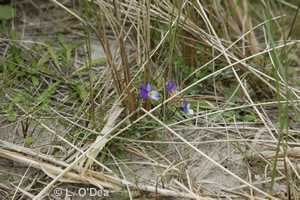 |
| Viola sp. in
Ballyteige Burrow Dune System |
Flora
Protection Order, 1999
The Flora Protection Order, 1999 lists the plant species protected by
section 21 of the Wildlife Act, 1976.
Included amongst these plants are a
number that regularly occur in coastal areas. It is illegal to cut,
uproot, damage or to offer for sale the listed species. In addition, it
is illegal to alter, damage or interfere in any way with their habitats.
This protection applies wherever the plants are found and is not confined
to sites designated for nature conservation. For the full text of the
Order, click here.
National
Biodiversity Plan
The National Biodiversity Plan was published in 2002 in response to obligations
contained in the Convention
on Biological Diversity. It sets out the framework through which Ireland
will provide for the conservation and sustainable use of biodiversity
for the period up to 2007. The overall objective of the Plan is to secure
the conservation, including where possible the enhancement, and sustainable
use of biological diversity (habitat, species and genetic) in Ireland,
and to contribute to conservation and sustainable use of biodiversity
globally. The Plan considers the integration of the conservation of biodiversity
into all relevant sectors (e.g. forestry, agriculture, fisheries and transport)
and outlines actions that will be pursued to achieve the overall objectives.
Actions are outlined for different ecosystems such as Terrestrial –
Agriculture and Forestry, Inland Waters and Wetlands, and Marine and Coastal.
For marine and coastal ecosystems the actions outlined include:
- Preparation of a national Integrated Coastal Zone Management Strategy;
- Development of a National Marine Biodiversity Resources Database; and
- Implementation of a prioritised programme of surveys and mapping of marine benthic species and communities.
European Community Biodiversity Strategy
 |
| Aquaculture in Killary
Harbour, County Galway |
The EU Biodiversity Action Plan for Fisheries establishes an action plan to improve or maintain biodiversity status and prevent biodiversity loss due to fisheries and aquaculture activities. The plan has the following priorities:
- promoting the conservation and sustainable use of fish stocks;
- promoting the control of exploitation rates and the establishment of technical conservation measures to support the conservation and sustainable use of fish stocks;
- reducing the impact of fisheries activities on non-target species and on marine and coastal ecosystems; and
- avoiding aquaculture practices that may affect habitat conservation.
To view the EU Biodiversity Action Plan for Fisheries, click here.
EU Directive 85/337/EEC (as amended by Directive 97/11/EC), on the assessment of the effects of certain public and private projects on the environment, lays down the requirements for environmental impact assessment (EIA). Its objective is to ensure that projects which are likely to have significant effects on the environment are subject to an assessment of their likely impacts. The Directive therefore sets out a procedure that must be followed for certain types of project before they can be given 'development consent'. The EIA procedure is a means of drawing together, in a systematic way, an assessment of a project's likely significant environmental effects, including those on natural and built heritage.
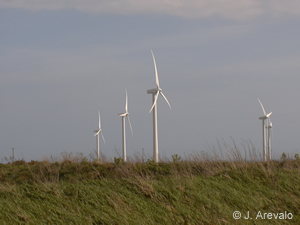 |
| Windfarm installations,
such as these in County Wexford, require an EIA before development
consent is given. |
EIA is mandatory for all projects listed in Annex I of the Directive
on the basis that these project classes will always have significant environmental
effects. In most cases, mandatory thresholds are specified in respect
of the project classes in Annex I. In certain cases e.g. integrated chemical
installations, EIA is necessary regardless of the size of the project.
Projects of the types listed in Annex II of the Directive must be subject
to EIA whenever they are likely to have significant effects on the environment.
In Ireland, the EIA requirements under planning legislation have been
consolidated into the Planning
and Development Act 2000 and the Planning
and Development Regulations 2001, which list projects requiring environmental
impact assessment. Click for the full text of the 1985
Directive and the 1997
Amendment.
Strategic
Environmental Assessment (SEA) Directive
The SEA Directive (2001/42/EC) provides for strategic environmental consideration
at an early stage in the decision making process, and is designed to complement
the environmental impact assessment (EIA) process for individual projects
provided for in the EIA
Directives. Strategic environmental assessment is the formal, systematic
evaluation of the likely significant environmental effects of implementing
a plan or programme before a decision is made to adopt the plan or programme.
SEA is designed to lead to more sustainable development through the systematic
appraisal of policy options. Furthermore, SEA plays an important role
in addressing the cumulative impacts of individual projects.
The objective of the SEA Directive is “to provide for a high level
of protection of the environment” and to “contribute to the
integration of environmental considerations into the preparation and adoption
of certain plans and programmes”. For the purposes of the Directive
‘plans and programmes’ are those that are “subject to
preparation and/or adoption by an authority at national, regional or local
level”. The Directive applies across a wide range of sectors e.g.
agriculture, forestry, fisheries, energy, industry, transport, waste management
and land use planning. The requirement to carry out SEA of plans/programmes
in the sectors mentioned above arises where they "set the framework
for future development consent of projects" which are listed in the
EIA Directives. SEA
is also necessary where plans/programmes are likely to have a significant
effect on a site governed by the Habitats
Directive. Responsibility for implementation of the Directive within
each sector rests primarily with the relevant Government
Departments. The SEA Directive was transposed into national legislation
by the European
Communities (Environmental Assessment of Certain Plans and Programmes)
Regulations 2004 and the Planning
and Development (Strategic Environmental Assessment) Regulations 2004;
collectively known as the SEA Regulations. For the full text of the SEA
Directive, click here.
For further information on SEA and Land-use planning, click here.
The
Heritage Act, 1995
The
Heritage Act established the Heritage
Council in order to ‘promote public interest in and knowledge,
appreciation and protection of the national heritage’. The Heritage
Act defines heritage as including the following elements:
-
Flora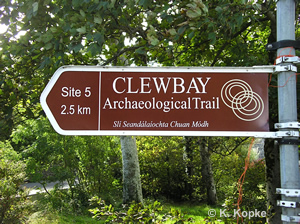 Clewbay Archaeological Trail, County Mayo
Clewbay Archaeological Trail, County Mayo - Fauna
- Wildlife habitats
- Monuments
- Archaeological objects
- Architectural heritage
- Wrecks
- Heritage objects
- Landscapes
- Seascapes
- Geology
- Heritage gardens and parks
- Inland waterways
Marine
Institute Act, 1991
The
Marine Institute Act established the Marine
Institute to ‘undertake, coordinate, promote and assist marine
research and development to enhance economic development and protect the
marine environment’.
Environmental
Protection Agency Act, 1992
The primary purpose of Environmental
Protection Agency Act was to provide for the establishment of the
Environmental Protection
Agency (EPA). The act also provides for certain other miscellaneous
matters relating to the environment.
NATIONAL
PLANNING POLICY
The National Heritage Plan states
that ‘it is an objective of the government to ensure the protection
of our heritage and to promote its enjoyment for us all’. It also
states that ‘Protection of our heritage must begin at the local
level, enabling everybody to become actively involved in preserving and
enhancing that which belongs to us. The key to achieving this goal is
the preparation and adoption of Local Heritage Plans involving local heritage
for bringing together communities, local authorities and the Government.
Local heritage plans will identify the steps necessary for the protection
and enjoyment of heritage at the local level’.
The Planning and Development
Act 2000 is Ireland’s principle legislation with regard to planning
and sustainable development in the country. It is defined as an act to
revise and consolidate the law relating to planning and development by
repealing and re-enacting with amendments the Local Government (Planning
and Development) Acts, 1963 to 1999; to provide, in the interests of the
common good, for proper planning and sustainable development.
LOCAL AUTHORITY PLANS
The main instrument used by Local Authorities for regulation and control
of development is the County Development
Plan. Individual Local Authorities may have specific action plans
for specific purposes in specific areas, e.g. Settlement Centre Plans
and Village Design Statements. More information on specific local authority
plans can be obtained from the Local Authority website or by contacting
the Planning Section of your Local
Authority. Additionally, most Local Authorities have issued guidance
documents on specific planning issues and policy, e.g. Protected Structures,
Graveyard Maintenance, Bats, Hedgerows, etc. More information on guidance
documents can be obtained from your local Heritage
Officer, Local
Authority Planning Office or the Heritage
Council.
County
Development Plans
Under the Planning and Development
Act 2000, planning authorities are required make a new plan every
6 years. The Plan states the authority's policies for land use (e.g. residential,
commercial, industrial, agricultural) and for development control and
promotion in its area. It lays out an overall strategy for the proper
planning and sustainable development of the county. County Development
Plans contain both policies and objectives, e.g., the Galway County Development
Plan (2003 – 2009) outlines the following policy and objectives
in relation to the Coastal Zone:
-
Policy 164: Protect and preserve the quality of the coastline.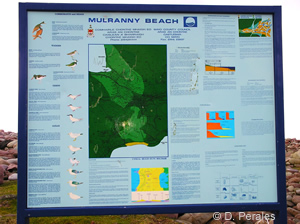 Signage provided by Mayo County Council at Mulranny Beach
Signage provided by Mayo County Council at Mulranny Beach - Policy 165: Protect flora and fauna and natural habitats along the coastline.
- Policy 166: Protect any views of special amenity value along the coastline.
Objective 65: Facilitate the provision of a coastal zone management plan for the county. Development plans must contain a set of objectives including a number relating to heritage:
- conservation and protection of the environment, including, in particular, the archaeological and natural heritage and the conservation of European sites;
- preservation of the character of the landscape;
- protection of structures of architectural, archaeological, historical, cultural and other interest;
- the preservation of the character of architectural conservation areas; and
- the protection of the linguistic and cultural heritage of the Gaeltacht.
Development plans may contain additional policies and objectives such as:
- preserving and protecting flora, fauna and ecological diversity;
- protecting features of the landscape which are of major importance for wild fauna and flora;
- preserving and protecting trees, shrubs, plants and flowers preserving the quality and character of urban or rural areas;
- protecting and preserving (either in situ or by record) places, caves, sites, features and other objects of archaeological, geological, historical, scientific or ecological interest;
- regulating and controlling the design, colour and materials of structures and groups of structures, including streets and townscapes and structures and groups of structures in rural areas; and
- preserving the character of the landscape, including views and prospects, and the amenities of places and features of natural beauty or interest.
County Heritage Plans
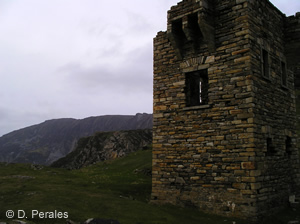 |
| Matello Tower with
Slieve League in the backround, County Donegal |
One of the key actions defined in the National Heritage Plan is the preparation of Heritage Plans at County and City level. The preparation of the County Heritage Plan is a progression of the work of County Development Plans in that it involves the development of strategies to achieve the heritage-related objectives of the County Development Plan. Heritage Plans may also deal with issues relating to heritage that are outside the remit of County Development Plans. County Heritage Plans do not follow a rigid format, but rather, seek the assistance of the community and other interested stakeholders, through County/City Heritage Fora, in identifying the actions needed in order protection local heritage taking into consideration local circumstances and local needs and wants. The plans are designed to:
- Improve understanding of local heritage;
- Improve access to local heritage information;
- Raise heritage awareness;
- Develop and implement of codes of best practice in heritage conservation and management;
- Identify specific actions to benefit heritage;
- Implement key projects, and
- Safeguard the heritage for future generations.
In general, the Heritage Council, Local Authorities and ‘Leader’
companies provide funding for projects contained in the Heritage Plans.
Other members of City and County Heritage Fora, such as academic institutions,
government departments and various agencies can also provide funding for
heritage action plans. It should be noted that this funding may be in
kind, e.g. provision of skills, equipment, etc. For more information on
funding for projects in the marine and coastal zone, click here.
County/City Heritage Plans are available on the websites of the various
Local Authorities
or the publications
section of the Heritage Council website.
Local
Biodiversity Action Plans
The preparation of Local Biodiversity Action Plans is part of an overall
process that the government has initiated to address heritage concerns
and to fulfill international obligations under the
Convention on Biological Diversity and Agenda 21 through the publication
of the National Heritage Plan and
the National Biodiversity Plan.
The National Biodiversity Plan requires each county to produce a Local
Biodiversity Action Plan and to designate Natural Heritage Officers. Local
Biodiversity Action Plans are a complementary component of County
Heritage Plans. The main functions of a Local Biodiversity Action
Plan are to translate Irish and international policies and legislation
into effective local action; to conserve biodiversity of national and
local importance; to collect and collate information on the biodiversity
of the area; and to raise public awareness of, and involvement in, the
conservation of biodiversity. The initial focus of Local Biodiversity
Plans is on the identification and assessment of the local biodiversity
resource.
The Co. Clare LBAP has been published and can be viewed by clicking here.
Information on other LBAPs is available from those Local Authorities who
have initiated plans, e.g. Co. Sligo, Co. Donegal, Co. Galway (Northeast)
and Dun Laoghaire-Rathdown County. Guidelines for the production of Local
Biodiversity Action Plans are available on the Heritage Council website,
here.
URLs
Planning
and Development Act, 2000 - http://www.irishstatutebook.ie/ZZA30Y2000.html
Planning
and Development Regulations, 2001 - http://www.irishstatutebook.ie/ZZSI600Y2001.html
Foreshore
Act 1933 - http://www.irishstatutebook.ie/ZZA12Y1933.html
Foreshore
(Amendment) Act, 1992 - http://www.irishstatutebook.ie/ZZA17Y1992.html
Fisheries
and Foreshore (Amendment) Act, 1998 - http://www.irishstatutebook.ie/1998_54.html
Foreshore (Environmental Impact Assessment) Regulations, 1990 - http://www.irishstatutebook.ie/ZZSI220Y1990.html
Framework and Principles Document - http://www.environ.ie/DOEI/DOEIPol.nsf/0
/086035e8bb62739c80256f0f003bc852/$FILE/FREWKENG.PDF
ICOMOS - http://www.icomos.org/
European Maritime Heritage - http://www.european-maritime-heritage.org/index.htm
National Monuments Act 1930 - http://www.irishstatutebook.ie/ZZA2Y1930.html
National Monuments (Amendment) Act 1954 - http://www.irishstatutebook.ie/ZZA37Y1954.html
National Monuments (Amendment) Act 1987 - http://www.irishstatutebook.ie/ZZA17Y1987.html
National Monuments (Amendment) Act 1994 - http://www.irishstatutebook.ie/ZZA17Y1994.html
Architectural
Heritage (National Inventory) & Historic Properties (Miscellaneous
Provisions) Act, 1999 - http://www.irishstatutebook.ie/ZZA19Y1999.html
Heritage Act 1995 - http://www.irishstatutebook.ie/ZZA4Y1995.html
The
Continental Shelf Act - http://www.irishstatutebook.ie/ZZA14Y1968.html
Wildlife
Act, 1976 - http://www.irishstatutebook.ie/ZZA39Y1976.html
Wildlife
Act, 2000 - http://www.irishstatutebook.ie/ZZA38Y2000.html
Whale
Fisheries Act, 1937 - http://www.irishstatutebook.ie/ZZA4Y1937.html
Natural
Habitats Regulations, 1997 - http://www.irishstatutebook.ie/ZZSI94Y1997.html
Conservation
of Wild Birds Regulations, 1985 - http://www.irishstatutebook.ie/ZZSI291Y1985.html
Flora
Protection Order, 1999 - http://www.irishstatutebook.ie/ZZSI94Y1999.html
OSPAR
Convention - http://www.ospar.org/eng/html/welcome.html
Ramsar
Convention - http://www.ramsar.org/.
Environment/Nature_and_biological_diversity/
Nature_protection/default.asp#TopOfPage
AEWA - http://www.cms.int/species/aewa/aew_bkrd.htm
IUCN
- www.iucn.org
CITES
- www.cites.org
Whaling
Convention - http://www.iwcoffice.org/
Habitats Directive
http://europa.eu.int/eur-lex/en/consleg/pdf/1992/en_1992L0043_do_001.pdf
Habitats
Directive - Annex I
Habitats
Directive - Annex II
Birds
Directive
http://europa.eu.int/eur-lex/en/consleg/pdf/1979/en_1979L0409_do_001.pdf
Birds
Directive - Annex I
http://europa.eu.int/comm/environment/nature/
nature_conservation/eu_enlargement/2004/birds/annex_i.pdf
EIA Directive 1985 - http://europa.eu.int/smartapi/cgi/sga_doc?smartapi!celexapi!prod!
CELEXnumdoc&lg=EN&numdoc=31985L0337&model=guichett (or provide pdf)
EIA Amendment 1997 - http://europa.eu.int/smartapi/cgi/sga_doc?smartapi!celexapi!
prod!CELEXnumdoc&lg=EN&numdoc=31997L0011&model=guichett (or provide pdf)
Planning and Development Regulations, 2001 - http://www.irishstatutebook.ie/ZZSI600Y2001.html
European Communities (Environmental Assessment of
Certain Plans and Programmes)
Regulations 2004 (these are not in online
Statute Book Yet) - http://www.environ.ie/DOEI/DOEIPol.nsf/0/b8aeb091f741ee9c80256f5d004cd61c/
$FILE/S.I.%20No.%20435%20of%202004.doc
Planning and Development (Strategic Environmental
Assessment) Regulations 2004
(these are not in online Statute Book Yet) - http://www.environ.ie/DOEI/DOEIPol.nsf/0/b8aeb091f741ee9c80256f5d004cd61c/
$FILE/S.I.%20No.%20436%20of%202004.doc
SEA Directive - http://www.environ.ie/DOEI/DOEIPol.nsf/0/
b8aeb091f741ee9c80256f5d004cd61c/$FILE/0142_en.pdf
SEA and land-use planning guidelines -
Government Departments - http://www.irlgov.ie/departments/default.asp
Heritage
Act 1995 - http://www.irishstatutebook.ie/ZZA4Y1995.html
Marine
Institute Act 1991 - http://www.irishstatutebook.ie/ZZA2Y1991.html
Environmental
Protection Agency Act 1992 - http://www.irishstatutebook.ie/ZZA7Y1992.html
Heritage Appraisal of Development
Plans - http://www.heritagecouncil.ie/publications/appraisal/index.html
Heritage Council Publications
- http://www.heritagecouncil.ie/publications/index.html#local
Clare LBAP - http://www.clare.ie/planning/docs/biodiversityincountyclare.pdf
Heritage Council Guidelines
for LBAPs - http://www.heritagecouncil.ie/publications/lbap/Guidelines_for_LBAP.pdf